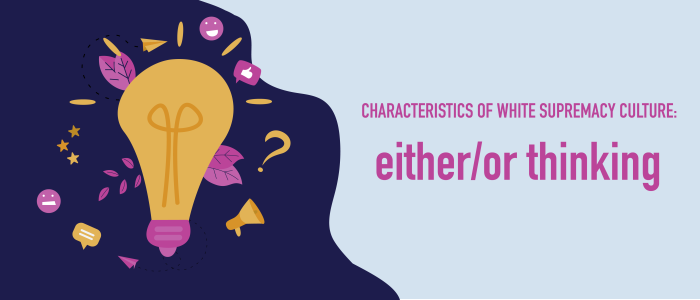
Analyzing white supremacy culture in the workplace: Perfectionism
Aug 9, 2022
This blog is a part of a series that highlights the 13 characteristics of white supremacy culture
What is white supremacy culture?
To give you a quick refresher from our previous blog in this series:
White supremacy culture builds upon the definition of white supremacy — thinking white people and their ideas, thoughts, beliefs and actions are better than people of color and their ideas, thoughts, beliefs and actions — and expands it by infiltrating our beliefs, values, norms, standards of our groups (many if not most of them), our communities, our towns, our states and our nation, teaching us both overtly and covertly that whiteness is valuable, that whiteness holds value, and that in order for anyone to gain value, they must utilize whiteness to do so.
Deconstructing the characteristics of white supremacy culture
There are 13 main characteristics of white supremacy culture:
- Paternalism
- Perfectionism
- Either/or thinking
- Fear of open conflict
- Objectivity
- Quantity over quality
- Worship of the written word
- Defensiveness
- Power hoarding
- Individualism
- Right to comfort
In this blog, we are going to talk about one of them and how it affects the workplace: Perfectionism.
Perfectionism: The backbone of overservicing.
The concept of perfectionism can be defined as a way of thinking that puts a high value on perfection, regardless of how over budget or overcapacity a project is. We, therefore, end up seeing mistakes in projects differently, and we begin to view them as flaws in the person who makes a mistake rather than the mistake itself. As a result, we lack the ability to be human at work, and we no longer have the ability to allow for grace in the workplace. You may be tempted to over-serve those clients if you have ingrained perfectionist tendencies, believing your attention to detail might result in a better-quality product, but it will also cause you and your team to go over the original scope of the project, burning out both of you in the long run.
Countering perfectionism and what it looks like in action.
Instead of focusing on the faults of the individual, try to highlight the strong points the person has and encourage them to move forward instead. By setting realistic expectations, remaining flexible, and being open to changing the timeline if necessary, perfectionism can be actively fought in real-time and proactively managed for any upcoming projects. Bad days, bad weeks and bad months are inevitable, but those moments of mistakes should not define you.
There needs to be an environment where people are encouraged to take risks and make mistakes, and then after they have made their mistakes, those mistakes should also be viewed as opportunities for learning to cultivate a culture of learning in your organization. For people to understand that mistakes can sometimes result in positive outcomes for the company, it is crucial to provide an environment in which people can feel comfortable making them.
To learn more about the characteristics of white supremacy culture, please refer to the dismantle racism homepage for more information.


